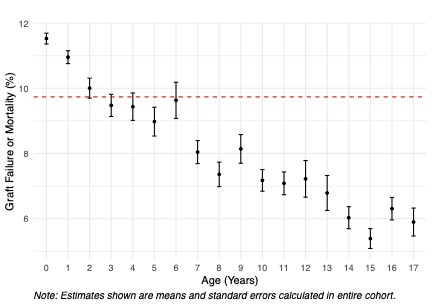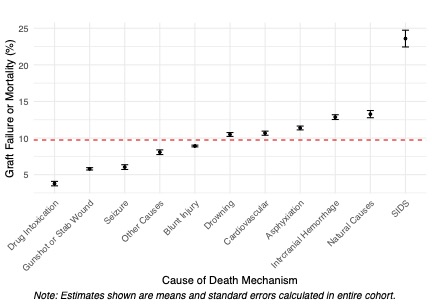
Pediatric Liver Donors, Not One in the Same: A Validated Donor Risk Score to Predict 1-Year Graft Loss or Mortality in Pediatric Liver Transplant Recipients
Stephen J Hartman1, Michela Carter1, David Merola2, Suzanne Evans1, Alexander J Bondoc1, Greg Tiao1, Jonathan Merola1.
1Pediatric General and Thoracic Surgery, Cincinnati Children's Hospital Medical Center, Cincinnati, OH, United States; 2Global Patient Safety-Pharmacoepidemiology, Eli Lily & Company, Indianapolis, IN, United States
INTRODUCTION: We aimed to develop a quantitative pediatric donor risk index for pediatric liver transplant recipients. Components of this validated pediatric donor liver risk score may inform risk assessment for pediatric liver recipients.
METHODS: The UNOS STAR registry was used to identify liver transplants between 6/30/2004-3/3/2023 involving donor and recipient both aged <18 years with 1-year follow-up. Candidate predictors for a composite outcome of death or graft loss within 1-year of transplant were selected based on measurement on or prior to the transplant date, having <30% missingness, and clinical relevance. Five penalized logistic regression models containing donor and recipient factors were constructed using different estimation procedures and ranked based on F1 score. The marginal effects of the donor factors from the best performing model were calculated to generate a numeric risk score. The score was validated in an independent cohort.
RESULTS:4,032 pediatric donor-recipient pairs were used to develop each model and 1,345 independent pairs were used to test model performance. A donor risk score was devised based on 17 donor factors from this predictive model and demonstrated strong correlation to 1-year graft loss and mortality (Spearman coefficient=0.9). Young donor age (<2 years) and SIDS, natural causes and intracranial hemorrhage as a cause of death higher donor risk while adolescent donors and those succumbing to drug intoxication and penetrating trauma demonstrated lower donor risk.
CONCLUSION: An empirically derived and validated risk score that can be applied for stratifying pediatric liver donors is presented


The WebApp is sponsored by:

If you have any questions during the meeting, please go to the registration desk. Our emails will be monitored sporadically.
REGISTRATION DESK OPENING TIMES
Thursday, May 1, 2025, 07:00-17:30 Friday, May 2, 2025, 07:00-12:00